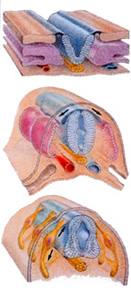Neurodevelopment
The brain has evolved to get a maximum number of neurons and neuronal connections into a limited space. A developing human embryo contains an outer layer of cells, known as the ectoderm, that folds in to create the neural tube. This tube develops into the spinal cord and brain. The remaining ectoderm cells continue on to become skin.
All multi-cellular organisms, including humans, are comprised of a community of eukaryotic cells (with a true nucleus). Some of these cells are neurons. Neurons conduct information throughout the body in the form of electrochemical impulses between cells.
Neurons communicate with other neurons via synapses. A synapse is the location along the axon of a neuron where it almost touches another neuron.
At these synapses, resulting from a buildup of electric potential, neurotransmitters (chemicals particular to the neurons involved) are released into a tiny space between the neurons and incite the receiving neuron to respond, perpetuating the movement of information.If a neuron is often in communication with another cell this connection is strengthened and more likely to fire. If they rarely communicate, the connection can atrophy and disappear. As an organism lives, different connections between neurons are enhanced or diminished depending on experience.
The content and intensity of mental impressions cause different patterns of neuronal activity. This ability for neurons to communicate and influence each other transduces sensory information into ideas and behavior.

